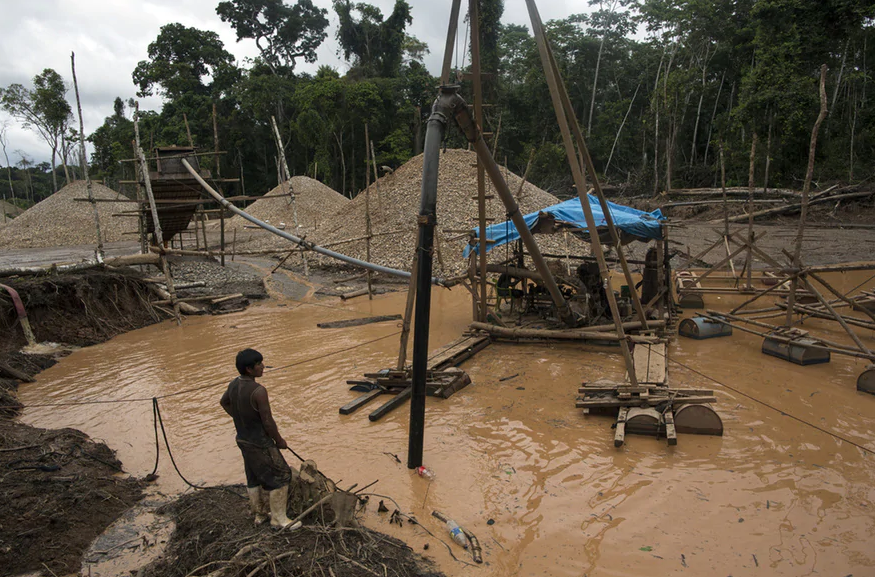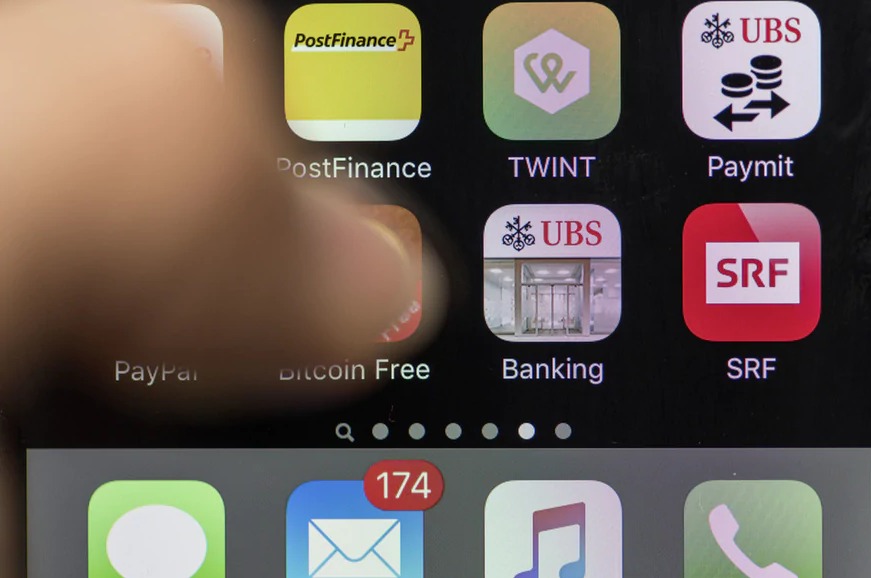The southeastern region of Madre de Dios in Peru is known for its illegal gold mining practices, but Chave insists PX Precinox does not source any of its precious metal from there. Copyright 2018 The Associated Press. All Rights Reserved. In a rare interview, PX Precinox CEO Philippe Chave defends his company’s record in Peru and says abandoning artisanal miners is not the way to achieve more sustainable and transparent mining practices. For years reports of environmental and labour abuses associated with gold mining in Peru have plagued Swiss refiners that sourced the precious metal from the South American country. Some companies decided to stop working with artisanal miners altogether due to the risks of trading in illegal gold. Others, including jewellers and
Topics:
Swissinfo considers the following as important: 3.) Swiss Info, 3) Swiss Markets and News, Business, Featured, newsletter
This could be interesting, too:
Nachrichten Ticker - www.finanzen.ch writes Die Performance der Kryptowährungen in KW 9: Das hat sich bei Bitcoin, Ether & Co. getan
Nachrichten Ticker - www.finanzen.ch writes Wer verbirgt sich hinter der Ethereum-Technologie?
Martin Hartmann writes Eine Analyse nach den Lehren von Milton Friedman
Marc Chandler writes March 2025 Monthly

The southeastern region of Madre de Dios in Peru is known for its illegal gold mining practices, but Chave insists PX Precinox does not source any of its precious metal from there. Copyright 2018 The Associated Press. All Rights Reserved.
In a rare interview, PX Precinox CEO Philippe Chave defends his company’s record in Peru and says abandoning artisanal miners is not the way to achieve more sustainable and transparent mining practices.
For years reports of environmental and labour abuses associated with gold mining in Peru have plagued Swiss refiners that sourced the precious metal from the South American country. Some companies decided to stop working with artisanal miners altogether due to the risks of trading in illegal gold. Others, including jewellers and watchmakers, have promoted initiatives for better transparency of the supply chain.
Last month the Swiss government proposed an amendment to the World Customs Organization that would allow for better traceability of gold. The change calls for imports to be differentiated between refined and unrefined gold. Some 70% of global gold is refined in Switzerland.
In Peru, Jura-based refiner PX Precinox has struck up a partnership with Minera Veta Dorada, an ore processor that buys gold from so-called artisanal small-scale miners who have been certified by the government or have applied to do so. This label nevertheless includes those working with heavy machinery, including excavators and trucks to transport the ore, a trend that has increased ever since gold prices began to spike during the 2008 financial crisis.
Veta Dorada, owned by the Canadian mining firm Dynacor, was recently named in an investigation following a nationwide police operation in which illegal mine shafts were exposed and gold shipments seized.
Among those arrested were members of criminal group “Los Topos” (The Moles). They had used the identities of miners who had applied for legal government status to transport gold ore illegally excavated from shafts hidden behind fake building facades.
Previously Chave has said that the gold that his company has purchased from Peru since 2015 was legitimate, adding that both his firm and the processor, located along the southern Pacific coast, were cooperating with investigators. He spoke to swissinfo.ch about the investigation and the challenges of sourcing “clean gold” from the region.
swissinfo.ch: How did you get started in Peru?
Philippe Chave: We saw a growing awareness in the market and among the public regarding the sourcing of gold. Twenty years ago, no one really cared about the conditions of its extraction. We thought it was an opportunity to come up with an additional level of traceability where we could show where gold came from, and under which conditions it was extracted. There was a huge gap and a huge potential.
Artisanal miners and the luxury industry represent the two extremes of the value chain. They depend on each other but don’t know one another. To help the artisanal mining sector, you need to educate the public and people in the industry to explain what is at stake and how we can support them. Some say the solution is industrial mining. But this is not possible. There are millions of people involved here who are just trying to survive. The only solution is to encourage them to formalise. If they don’t pay tax, how can they achieve the much-needed infrastructures, and how can you talk about traceability?
With Dynacor, we found a partner who shares our values and vision and decided to establish this strategic alliance.
Where does the gold ore come from that is processed at the plant you work with, located in Chala (along the southern Pacific coast)?
From all over Peru, and from different ore producers. It starts with a basis of some 400-600 miners, but that number fluctuates as miners may sell to other plants as well. Dynacor has a list of criteria that miners need to fulfil, such as being registered with the government, having a tax ID number, and the right to work on a concession. Verifications are done on every single transaction.
Miners have a choice. They could use traditional methods using mercury to recover gold by themselves, but we estimate that they only recover 50% of the gold [in this way]. Instead, (if they supply Veta Dorada), Dynacor can recover 95%, and they conduct business like we would do in Switzerland. They use chemicals in the process in a proper industrial set-up, but not mercury. As Dynacor offers a high recovery rate, it could be (more) attractive to miners to sell their ore to the processor.
How does your end of the business operate?
We charge our customers (jewellers and watchmakers) an “impact’’ premium according to the quantities they commit to purchasing over a year, at a rate that is financially acceptable to the market. We are transparent in what we do with those funds. One hundred percent of that is used on the impact projects. It creates a snowball effect. The more we invest in those communities, the more the miners realise the interest in becoming engaged in the formalisation process. As more people are qualified to sell their ore, the more gold we bring to the market and the more premium we can inject back into the community. That is the dynamic that we are trying to generate.
You have said that the conditions are favourable for miners. What do you mean?
The miners are not captive. When they offer to sell gold ore, purity tests are done on the batch to determine if it is sulphurised or oxidised ore and how much gold there is. If the miner thinks the amount of gold calculated is competitive, he would stay with Dynacor. If he thinks he could get a better deal elsewhere, then he could sell at another plant.
How is the gold extracted, and how much gold is normally extracted from a ton of ore?
The average is about 0.8 ounces per tonne, or 24 grammes. The gold is extracted from narrow veins in the rock that make it difficult to extract industrially. Those veins are therefore suitable for the artisanal sector to mine. As the gold is concentrated in those hard-to-access veins, the content must be high in those veins – otherwise it is not worthwhile to extract.
What happened at the time of the police raids in February?
We were informed by Dynacor on the day that it happened. All the transactions and business conducted with people connected to the investigation were confirmed and compliant. We have quite a large number of miners whom Dynacor works with, and verify every one of those transactions.
Of all the miners that Dynacor works with, there were five individuals who were declared legal by the authorities, and who had concessions from where they extracted gold. But it appeared that those guys were also involved in mining gold in a municipal area where it was not authorised.
Were the same miners involved in illegally extracting gold in Parcoy in Northern Peru also doing business with Dynacor-Veta Dorada?
The five miners at some point had been conducting business transactions with Minera Veta Dorada. That is why the gold that was about to be exported was preliminarily seized, to see if there were any links to “Los Topos”. There have been no charges or arrests as far as Dynacor is concerned, because everything suggests that there was full compliance.
While the local press said that massive quantities of gold were laundered to Switzerland, that is wrong. All the gold that has been imported is legal. Shortcuts in interpretations are easily taken, especially when the only source of information is the media in Peru. The fact is that there was no flow of illegal gold between Peru and Switzerland.
Do you worry about with whom you may be engaging in business?
Yes, we are concerned, and so is Dynacor. We therefore strive to go one step further in our verification process and add extra layers to that verification. The recent events are not something we want to be associated with nor does Dynacor wish to be. This is very counter-productive and not in line with the values of our companies. We are determined to tackle this. But it is a complex world, especially in the mining world in Peru. We need to find the right measures to put in place moving towards zero risk.
How risky is it to be operating in Peru?
Mining is always risky, especially when sourcing from artisanal miners, and when many sources are involved. To put things into perspective, when we speak about illegal gold from [the southeastern mining region of] Madre de Dios, we speak about deforestation, mercury pollution, child labour, people trafficking, etc. And Dynacor never purchases ore from those highly sensitive areas. That’s what is called illegal gold. In the case of what occurred in this incident, the miners were not working in a conflict zone and mercury was not spilt. We should therefore put things into perspective. People are often mixing things up.
Last year, another Swiss gold refiner, Metalor, decided to stop importing gold sourced from artisanal mines in Latin America (after it had suspended imports from Peru). But after the company was criticised for not supporting sustainable sourcing, it announced that it was working with a small-scale mining company in Peru and the Swiss Better Gold Initiative to encourage artisanal gold producers Are Swiss gold refiners re-thinking their strategies?
You can see what we do. I am not saying it is all perfect in a Swiss environment. We are moving forward trying to make things change. After Metalor made the announcement last year, customers asked us if we were still buying from Peru. We told them yes. We had been pressured by some customers to do the same. This is precisely why we are sitting here together to create that dialogue. Otherwise it is counter-productive, in the Swiss luxury industry and in terms of risk and reputation.
There are some people doing a very good job in artisanal mining. We chose a good partner in the field. This is a good example of a success story in transparency. Many artisanal miners are organised like SMEs (small and medium sized enterprises), they are small scale, and they are mechanised.
To say, “let’s abandon all of that” is not the solution and would only result in pushing artisanal miners towards informality. But when it comes to the media, of course, we need to say what is wrong. But we must do this through consultation and constructive dialogue. Because in the end, the alternative result is that a refiner is congratulated for withdrawing from the artisanal sector. But is this what it means to act responsibly?
How are audits and verifications being carried out during the pandemic, since flights and even national transport in Peru have been halted because of the lockdown?
Verifications still need to be done, with or without Covid. There are no transactions without verification. We have a programme with additional layers of checks for which this restriction of movement is an obstacle. We are doing the best with what we have and continue with verification for every single transaction.
After the start of the pandemic, Peruvian customs data showed that shipments to PX Precinox were going through Miami (another major global refining centre), instead of being flown directly to Zurich.
The logistics changed due to Covid-19. Normally high value transportation is handled through commercial flights and not through cargo flights. The usual routes are not available. Now, goods have to go from Lima to Florida, and then somewhere in the Middle East, before arriving in Zurich. Unfortunately, right now there are no other ways to get the gold to us.
How well is Peru doing in terms of trying to help miners move and do away with illegal practices?
We believe there is potential in Peru. But there are huge challenges. Nevertheless, we believe things can be improved and we have a role to play. We need all stakeholders to be involved. Alone, we cannot solve problems that have been unsolved for decades. We need the support of the public, the media, the NGOs and the market.
Tags: Business,Featured,newsletter








